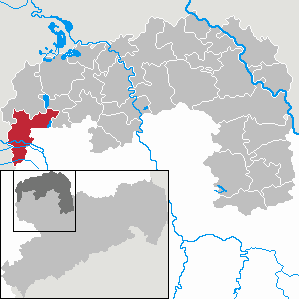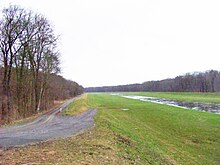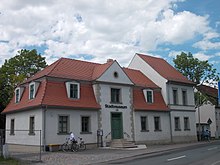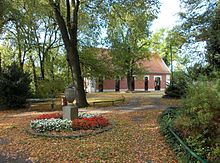Schkeuditz
| coat of arms | Germany map | |
|---|---|---|

|
Coordinates: 51 ° 24 ' N , 12 ° 13' E |
|
| Basic data | ||
| State : | Saxony | |
| County : | North Saxony | |
| Height : | 111 m above sea level NHN | |
| Area : | 81.47 km 2 | |
| Residents: | 18,312 (Dec. 31, 2019) | |
| Population density : | 225 inhabitants per km 2 | |
| Postal code : | 04435 | |
| Primaries : | 034204, 034205, 034207 | |
| License plate : | TDO, DZ, EB, OZ, TG, TO | |
| Community key : | 14 7 30 270 | |
| City structure: | 10 districts | |
City administration address : |
Rathausplatz 3 04435 Schkeuditz |
|
| Website : | ||
| Lord Mayor : | Rayk Bergner ( CDU ) | |
| Location of the town of Schkeuditz in the northern Saxony district | ||
Schkeuditz ( ˈʃkɔʏdɪts ) is a large district town in the district of North Saxony in northwest Saxony . It is halfway between Leipzig in the southeast and Halle in the northwest and is the third largest city in the district. Schkeuditz is best known as the location of the Leipzig-Halle Airport , which is located north of the city, and for the Schkeuditzer Kreuz , Germany's first motorway junction.
geography
location
Schkeuditz is located on the White Elster between Leipzig and Halle in the Leipzig lowland bay . The northern area is flat, forest-free and is used for agriculture or the airport. To the south of the city, the Elster meadows with the Neue Luppe , Luppe and Elster-Saale Canal stretch as a natural river landscape. Schkeuditz is about 100 meters above sea level. In the north-east of the city lies the Schladitzer See , a flooded open-cast brown coal mine. Schkeuditz is a member of the Leipzig Green Ring Association .
The average annual temperature is 8.4 ° C and the average annual rainfall 556.8 mm (average 1972-2001).
Schkeuditz is classified as a medium-sized center in state planning and takes on this function for the surrounding areas between Halle and Leipzig.
City structure
The municipality of Schkeuditz consists of the core city and nine villages in the area.
As of June 30, 2006, the new towns had the following population figures
|
|
Other settlements are Altscherbitz , Modelwitz , Papitz , Wehlitz , Lössen , Ennewitz .
history
Schkeuditz was first mentioned in 981 under the name "scudici" as a parish church in the diocese of Merseburg . In 1271 Schkeuditz was sold by the Margrave of Landsberg to the Prince Diocese of Merseburg , which in 1436 also gave the town its city rights. To 1815 was chief town of Schkeuditz hochstiftlich-merseburgischen Office Schkeuditz , which since 1561 under electoral Saxon stood sovereignty and between 1656/57 and 1738 for Sekundogenitur -Fürstentum Saxe-Merseburg belonged.
From 1621 to 1622 there was a kipper mint in the city , in which interim coins (kipper coins) were struck under the mint master Heinrich Ulm. They were cruiser pieces and Kipper- Schreckenberger .
During the Thirty Years War Schkeuditz was burned down twelve times and looted nine times.
At the end of the 17th century the city fortifications were dismantled. During the Seven Years' War the city was occupied by Prussia and had to pay taxes to the Prussian military. In 1813, the Leipzig area was an important scene of the Wars of Liberation , which is why Schkeuditz was besieged several times by Prussians, French and Russians.
As a result of the Congress of Vienna , Schkeuditz went with the western part of the Schkeuditz office in 1815 from the Kingdom of Saxony to the Province of Saxony in the Kingdom of Prussia and became part of the Merseburg district in the Merseburg administrative district . The name of the inn at the state border is reminiscent of the border between Saxony and Prussia.
Industrialization in the city began in 1840 with the connection to the Magdeburg – Leipzig railway line . In 1845 the freedom of trade was issued , which promoted economic growth. The largest malt factory in Europe was built in Schkeuditz in 1873. The upswing continued, so that the connection to the power grid took place in 1901 and a tram connection to Leipzig existed from 1910 . In the same year, the fountains disappeared from the city and a water pipe began operating. The Leipzig / Halle Airport was built in 1927 on Schkeuditzer area. Since then, it has been of great importance to the city and is considered the most important airport in the new federal states outside of Berlin.
In 1858 the Schkeuditz furrier guild was founded by eleven masters; in 1926 it already had 54 members. The fur trade was the largest industry and the largest taxpayer in the city at the time, in particular because of the tobacco goods dressers and refiners who were also united in this guild . The decisive factor for the establishment of the branch in Schkeuditz was the proximity to the Leipziger Brühl , at times the world's largest fur trade center. The decline of the industry in the region began after the Second World War when the fur wholesalers moved to West Germany, especially to Frankfurt am Main . Until about the turn of the century , VEB Edelpelz Schkeuditz, previously KWU Stadtpelz-Veredlung, existed with two plants. Plant I was housed in the building of the former fur wholesale and finishing company Thorer & Co. and the animal hair processing company Rödiger & Quarch.
The former manor Altscherbitz , located southeast of the city, was owned by Albert von Carlowitz among others in the 19th century . From 1876 it was used as the provincial lunatic asylum Altscherbitz . This served in the 1930s and 1940s as an "intermediate facility " for the Bernburg killing center as part of the T4 campaign .
Papitz, Modelwitz and Altscherbitz have been Schkeuditz districts since 1929.
American troops entered the city on April 18, 1945 , before being replaced by the Red Army on July 2 . About 4,500 refugees came to the city after the end of the war. Schkeuditz, which had previously belonged to Saxony-Anhalt ( Merseburg district ), came to the Leipzig-Land district in the Leipzig district in the course of municipal reform in the GDR in 1952 .
On January 1, 1999, the town of Schkeuditz, which had been enlarged by Glesien and Radefeld, moved from the district of Leipziger Land to the district of Delitzsch , while 556 hectares and 7 residents were spun off from the former community of Radefeld to Leipzig.
Since January 1st, 2008 Schkeuditz belongs to the district of North Saxony . On January 1, 2009, it was raised to the status of a major district town.
Incorporations
| Former parish | date | annotation |
|---|---|---|
| Altscherbitz | 1929 | |
| Burghausen | 01/01/1994 01/01/2000 |
Merger with Dölzig and Rückmarsdorf zu Bienitz, reclassification to Leipzig |
| Bienitz | 01/01/2000 | Dissolution of the community |
| Dölzig | 01/01/1994 01/01/2000 |
Merger with Burghausen and Rückmarsdorf zu Bienitz, reclassification to Schkeuditz |
| Freiroda | 03/01/1994 | Incorporation to Radefeld |
| Gerbisdorf | December 01, 1972 | Incorporation to Freiroda |
| Glesien | 01/01/1999 | |
| Hayna | 07/01/1973 | Incorporation to Radefeld |
| Little love | 01/01/1957 01/01/2000 |
Incorporation to Dölzig, reclassification to Schkeuditz |
| Kursdorf | 01/01/1994 | |
| Loosen | 07/01/1950 | Incorporation to Wolteritz, devastated in 1985 by the Breitenfeld opencast mine |
| Model joke | 1929 | |
| Papitz | 1929 | |
| Priestly | 01.06.1973 01.01.2000 |
Incorporation to Dölzig, reclassification to Markranstädt |
| Radefeld | 01/01/1999 | Partial outsourcing to Leipzig (7 inhabitants) |
| Rückmarsdorf | 01/01/1994 01/01/2000 |
Merger with Dölzig and Burghausen zu Bienitz, reclassification to Leipzig |
| Wehlitz | 07/01/1950 | |
| Wolteritz | 03/01/1994 | Incorporation to Radefeld |
Population development
Development of the population:
|
|
|
|
* according to the current territorial status
politics
Municipal council
After the local elections on May 26, 2019 , the city council is composed as follows:
| Party / list | Seats | G / V |
| Free voters | 9 | + 2 |
| CDU | 5 | - 1 |
| LEFT | 2 | - 1 |
| SPD | 2 | - 1 |
| FDP | 2 | + 1 |
| Green | 2 | ± 0 |
P / L = change from 2014
coat of arms
Blazon : "In red from a humiliated shield , inside in gold a continuous black bar cross , a growing, facing, decapitated saint in natural colors in a silver robe, holding a silver book in his hands, lying on his black-bearded, gold- nimbed head."
Declaration of coat of arms: The saint is Alban von Mainz , patron saint of the city church. It was first mentioned in a document in 1436, but was known as a relief on the church as early as 1200. The black cross in gold was the symbol of the diocese of Merseburg . According to legend, Albanus is said to have carried his head to the burial site himself after his beheading, hence the depiction in the coat of arms in the white dying robe with the head on the book.
According to a legend, another Wapper explanation: Albanus was a man from Schkeuditz who was accused of stealing canvas. After torturing and confessing, he was taken to the execution site. Before that, however, he exclaimed: “As I am innocent, I will catch my head in my arms!” The people present were horrified to see the announced miracle and depicted God's judgment in the city's coat of arms.
Town twinning
- Seelze ( Lower Saxony )
- Bühl ( Baden-Wuerttemberg )
- Villefranche-sur-Saône in Beaujolais ( France )
- Oslavany ( Czech Republic )
- Mattsee ( Austria )
- Cantù ( Italy )
- Vilafranca del Penedès ( Spain )
- Călăraşi ( Republic of Moldova )
Culture and sights
→ see also: List of cultural monuments in Schkeuditz
Museums and planetarium
The city museum is located in Mühlstrasse, with the focus on prehistory and early history, city history, handicrafts and toys.
In addition, the Astronomical Center , which also includes a planetarium , has been located in Schkeuditz since 1978 . The district of Modelwitz is known for the toy museum.
Art Kapella and Culture House
A former chapel in the old cemetery was converted into an exhibition hall under the name Art Kapella Schkeuditz . Various art exhibitions are shown here every six weeks. Much emphasis is placed on a balanced relationship between internationality and regional ties. The Art Kapella choir is also known beyond the borders of Schkeuditz and has a long-standing friendship with the Arion Glesien choir (formerly the Glesien Mixed Choir ).
The Kulturhaus Sonne, which is located directly on the market and offers space for around 500 guests, was first mentioned 450 years ago as Gasthof Goldene Sonne . The ballroom was inaugurated in 1892. The cash factory Walter and Paul Lehmann was located in the house from July 1920 to October 1922. From 1927 to 1937 the sun housed the M. Wachsmuth book printing company from 1927 to 1937. In 1937 Albert Werther took over the book printing business and ran it in the house until 1953. Only a little later they planned to set up a cultural center. It was inaugurated on October 7, 1958. Concerts and events are held here regularly to this day. From 2000 to 2002 the building was extensively renovated. The Leipzig Symphony Orchestra is a regular guest at the Kulturhaus .
Buildings
In the district of Kleinliebenau there is a manor church on the ecumenical pilgrimage route with an extensive cultural life.
In the district of Dölzig there is a late Gothic collegiate church with a choir closed on three sides, with tracery windows and a star vault. The cross-rectangular west tower with coupled round arched windows is a reference to the original Romanesque church. At the beginning of the 16th century, a sundial was installed on the south-east pillar. In 1706 the church was rebuilt. During this renovation, the nave probably received its plastered wooden ceiling in the form of a mirror vault as well as the wooden altar with four Corinthian columns, Moses and John the Baptist on the side, Christ with the flag of the cross on the roof and the pulpit with figurative representations of the four evangelists. The pulpit cover is crowned by a sun with figures of angels. In the church there is also a recently restored baptismal angel with a palm branch that hovers over the baptismal font.
Green spaces and recreation
The clay pools near Papitz are a special habitat for animals and plants. In this area clay was extracted for brick making. After the concrete age had begun, the Altscherbitzer brickworks closed in 1960 and the Modelwitzer brickworks in 1974. The youngest clay mining areas - the Papitzer Lehmlachen and the Große Gehege - are part of the Luppenaue nature reserve established in 1990 .
More Attractions
- Alluvial forest with the excursion restaurants Domholzschänke and Goldener Hirsch in Dölzig.
- other churches in Freiroda, Gerbisdorf, Glesien, Hayna, Radefeld; Schkeuditz (Protestant and Catholic) and Wolteritz.
- Rittergüter u. a. in Modelwitz and Wehlitz
- Schladitzer See including a "Biedermeier beach"
- Technical monument bucket wheel SRs 6300 near Gerbisdorf from the former open pit mine in Breitenfeld.
Memorials
- Memorial stone in front of the municipal office in the Dölzig district for all victims of National Socialism
- Graves in the local cemetery of Dölzig for the murdered anti-fascists Kurt Schröter , Kurt Mätschke and Paul Wäge as well as for an unknown citizen of the Soviet Union
- Grove of honor in the Schkeuditz local cemetery for Soviet prisoners of war who were victims of forced labor
- Memorial stones in the courtyard of a training workshop in Delitzscher Strasse and in the school at Ringstrasse 10 in memory of the communist Kurt Beyer , who died in 1941 in the Dachau concentration camp , were removed after 1990
Sports
In Schkeuditz, a total of 56 sports clubs offer activities in over 120 sports. Although Schkeuditz is in the lowlands, mountaineering and skiing are also part of it. One focus of the clubs is the sporting promotion of children. In football , especially the SC Eintracht Schkeuditz is active, whose first men's team and the first women's team play in the Leipzig city league for the 2014/15 season. In handball , TSG Schkeuditz is represented by the first women's team in the Association League of Saxony. This club also offers athletics, skiing, volleyball and other popular sports.
Regular events
- The city festival takes place in Schkeuditz at the end of June. Concerts and theater performances as well as a large fairground are held throughout the city during the three-day festival. Every year in autumn, the city's associations organize the Schkeuditz Culture Days . Organized under the umbrella of the KulturKreis e. V.
- The North Saxon Choir Festival takes place annually in Radefeld at the beginning of May. The meeting of choirs from the region and beyond is organized and hosted by the Arion Glesien choir.
Economy and Infrastructure
economy
The city's economy is dominated by Leipzig / Halle Airport . This also results in a very good quota of 814 jobs per 1000 inhabitants, which means that there are more jobs in Schkeuditz than employable people. That's why the city is a commuter city. There are numerous companies in the logistics sector in Schkeuditz, for example Deutsche Post operates a mail and parcel center here . With the DHL Hub Leipzig, the postal subsidiary DHL has located its European air cargo hub including the aircraft maintenance company European Air Transport Leipzig here, and the city is the headquarters of the cargo airline Aerologic , a joint venture between DHL and Lufthansa Cargo. In addition, there are various companies such as Bitzer and Faiveley Transport Leipzig as the successor to the former Maschinen- und Apparatebau Schkeuditz (MAB), once the largest operation of the air and refrigeration technology combine in the GDR with 3,500 employees .
There are two hospitals in the Altscherbitz district: The Helios Clinic Schkeuditz (135 beds) as a hospital for standard care and the Saxon Altscherbitz Hospital as a specialist clinic for psychiatry and neurology (235 beds). In 1999, the long-term care area became the sponsorship of the Kreisverband der Volkssolidarität Leipziger Land / Muldental eV, which founded the "Lebensgemeinschaft am Elstertal" as a place to live for people with mental and multiple disabilities.
traffic
Schkeuditz is a traffic junction. At the Schkeuditzer Kreuz , located immediately northwest of the city, the federal autobahn 9 ( Berlin - Munich ) and the federal autobahn 14 ( Magdeburg - Dresden ) meet. The city can be reached on the A 9 via the Großkugel junction (16) and on the A 14 via the Schkeuditz (21) junction. The district of Dölzig can be reached via the Leipzig-West junction (17) of the A 9 in the directly adjacent Saxony-Anhalt.
The federal highway 6 leads through the city in an east-west direction from Halle to Leipzig and in a north-south direction the federal highway 186 from Schkeuditz to Markranstädt .
Schkeuditz is connected to the railway network via the Magdeburg – Leipzig railway and the (Ebensfeld–) Gröbers – Leipzig railway. The S-Bahn stations Schkeuditz and Schkeuditz West, which are served by the S3 of the S-Bahn Central Germany, are located on the former . On the latter route is the Leipzig / Halle Airport train station , which is served by S-Bahn, regional express and long-distance trains. The Merseburg – Leipzig-Leutzsch railway line , which was closed in 1998, and the unfinished Elster-Saale Canal run through the Dölzig district .
The city is connected to the local public transport by tram line 11 of the Leipziger Verkehrsbetriebe . It has its final stop in the center of Schkeuditz. The line was opened in 1910 by the Leipziger Außenbahn AG (LAAG) . Schkeuditz is also connected by two PlusBus and other regional bus routes.
Leipzig / Halle Airport is located north of the old city center and thus in the northern part of the city .
schools
Schkeuditz has four primary schools, one in Dölzig and one in Glesien, as well as a high school, a grammar school and a vocational school center.
Personalities
sons and daughters of the town
- Abraham Suarinus (1563-1615), Lutheran theologian
- Carl Melchior Bose (1681–1741), councilor and consistorial councilor as well as canon and senior of the Merseburg monastery
- Johann Michael Barth (1723–?), Physician and personal physician to the Chancellor of Lithuania
- Gottfried August Pietzsch (1759–1840), clergyman, educator and writer
- Constantin Schroeter (1795–1835), genre and portrait painter of the Biedermeier period
- Louis Kuhne (1835–1901), naturopath, born in Lössen
- August Trinius (1851-1919), writer
- Max von Bleichert (1875–1947), German industrialist, heir to Adolf Bleichert
- Wilhelm Binroth (1891–1964), painter
- Siegfried Bröse (1895–1984), administrative lawyer, Prussian district administrator and Baden regional councilor, born in Wolteritz
- Helmut Welz (1911–1979), officer, book author and Lord Mayor of Dresden
- Alfred Trebchen (1915–2011), MdL, Lord Mayor of Lüneburg (SPD), born in Dölzig
- Gerhard W. Menzel (1922–1980), writer
- Gerulf Pannach (1948–1998), rock poet, composer, singer and guitarist, among others for Renft
- Frank Siebeck (* 1949), hurdler
- Tasillo Römisch (* 1954), space historian with his own museum
- Christian Köckert (* 1957), former Interior Minister of Thuringia (CDU), born in Dölzig
- Markus Teutschbein (* 1971), conductor, church musician and Kapellmeister
- Mark Siebeck (* 1975), national volleyball player
- Peter Sack (* 1979), shot putter
- Dirk Laucke (* 1982), playwright
- Martin Hoffmann (* 1985), journalist
In addition, the Lessing family comes from Schkeuditz. A family history published privately by the Lessings as well as the complete works of Gotthold Ephraim Lessing in first editions are available in the Schkeuditzer Heimatmuseum.
Persons connected to Schkeuditz
- Friedrich II. Von Hoym (unknown – 1382), Catholic bishop, acquired the city for the diocese of Merseburg in the 14th century
- Christiane Sophie Ludwig (1764–1815), writer, lived and died in Schkeuditz
- Ewald Rudolf Stier (1800–1862), theologian and hymn poet, from 1850 to 1859 superintendent and pastor in Schkeuditz
- Albert von Carlowitz (1802–1874), Saxon and Prussian politician, lived on Gut Altscherbitz
- Adolf Bleichert (1845–1901), entrepreneur, founder of a machine factory and iron foundry in Schkeuditz
- Hermann Siebold (1873–1951), politician (SPD), died in Schkeuditz
- Anna Hübler (1876–1923), politician, died in Schkeuditz
- Paul Schnabel (1887–1947), ancient historian and ancient orientalist, died in Schkeuditz
- Günther Ramin (1898–1956), organist, harpsichordist, choir director and composer, lived with his family in Schkeuditz from 1903
- Johannes Volkmann (1889–1982), surgeon, was chief physician at the Schkeuditz Hospital
- Fritz Karwath (1925–1995), clown Caro, lived in Wolteritz since 1985
- Manfred Losch (1938–2009), athlete, died in Schkeuditz
- Hans Ticha (* 1940), painter, graphic artist and book illustrator, went to school in Schkeuditz from 1946 to 1958
- Gerda Viecenz (1944–2005), promoter of the fine arts, founded the socio-cultural center Art Kapella Schkeuditz
literature
An extensive tradition of the city of Schkeuditz for the period 1630-1945 on imperial, constitutional and community affairs, finances, military and war affairs, health and social affairs, trade, trade, agriculture, order and security police, fire protection, statistics, elections, School, church, building administration, guilds, associations, the communities Papitz-Modelwitz, Wehlitz and Altscherbitz are in the Saxon State Archives, State Archives Leipzig, stock 20625 City of Schkeuditz.
Web links
- City administration of Schkeuditz
- Schkeuditz in the Digital Historical Directory of Saxony
- Views of Schkeuditz
- Schkeuditz and its natural environment
- Delivery to Schkeuditz station in the holdings of the Reich Railway Directorate in Halle in the Saxony-Anhalt State Archives, Dessau department
Individual evidence
- ↑ Population of the Free State of Saxony by municipalities on December 31, 2019 ( help on this ).
- ^ Karlheinz Blaschke , Uwe Ulrich Jäschke : Kursächsischer Ämteratlas . Leipzig 2009, ISBN 978-3-937386-14-0 , pp. 84 f.
- ^ The district of Merseburg in the municipal directory 1900
- ↑ signed -m: The flag consecration of the Schkeuditz furrier guild on Sunday, May 16, 1926 . In: Kürschner Zeitung, No. 15 of May 21, 1926, 43rd year, Verlag Alexander Duncker, Leipzig, p. Ad
- ↑ Holdings and partial holdings of the Leipzig City Archive : 1.3.2.20 VEB Edelpelz Leipzig ( Memento from February 28, 2013 in the Internet Archive ), Leipzig City Archive 2009 (PDF; 465 kB).
- ↑ StBA: Changes in the municipalities in Germany, see 1999
- ↑ Schkeuditz election results 2019
- ↑ Schkeuditz seat distribution 2019 (provisional) , accessed on June 19, 2019
- ↑ Lexicon cities and coats of arms of the GDR , author collective Dr. Karlheinz Blaschke, Prof. Gerhard Kehrer, Heinz Machatscheck, VEB Verlag Enzyklopädie Leipzig 1979.
- ^ Walter Saal: Legends of the Merseburg district . VEB Druck Merseburg, 5th edition, Merseburg 1986.
- ↑ Choir Arion Glesien . Last accessed on May 25, 2018.
- ^ Dölzig Collegiate Church . Church district Leipzig. Retrieved September 13, 2014.
- ↑ Choir Arion Glesien
- ↑ 20625 City of Schkeuditz. In: State Archives Leipzig. Retrieved March 27, 2020 .





















